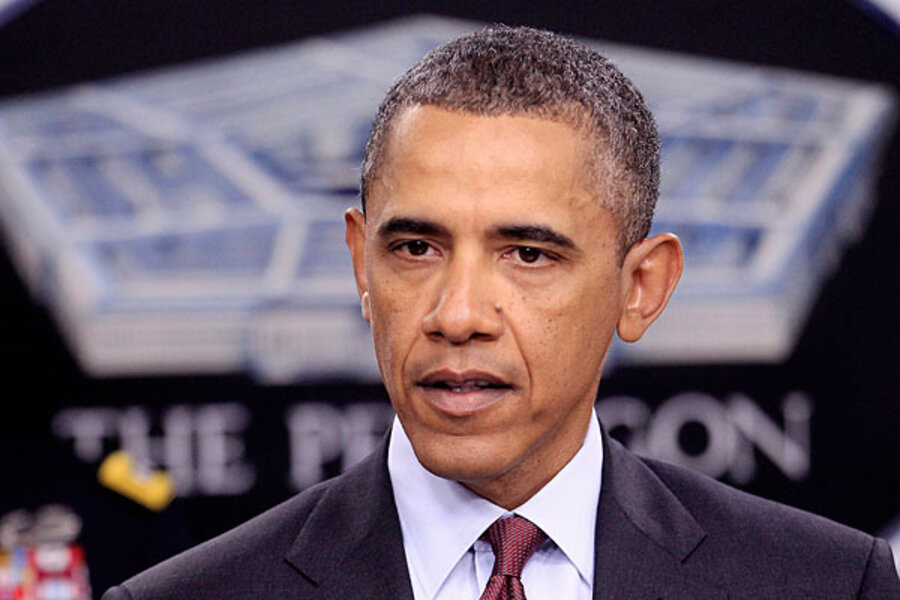New Pentagon strategy recasts military in Obama's image
Loading...
| WASHINGTON
With the inherited wars of Iraq and Afghanistan now receding, President Obama took his boldest step yet Thursday to recast the Pentagon’s priorities to reflect his own.
The specifics of the new defense strategy he released Thursday will trickle out in coming weeks as the administration lays out its next budget. But its contours bear the president’s imprint to a significant degree, with Defense Secretary Leon Panetta saying Mr. Obama was involved in long and detailed review discussions.
Both in reorienting the Pentagon’s attention toward the Pacific and away from the long and costly boots-on-the-ground invasions that characterized the last decade, Obama has put his stamp on the military. The fact that he, for the first time, delivered such an announcement from the Pentagon itself underscored the message.
Indeed, while the impetus for the review might have been the need to cut Pentagon spending by at least half a trillion dollars, Obama said the strategy is about more than just budgeteering.
“Now, we’re turning the page on a decade of war,” he said.
[ Video is no longer available. ]
Iran’s recent saber-rattling and its threats to put a choke hold on the global economy by closing the Strait of Hormuz point to why the strategy has the broader Middle East as one of its two geographical focal points. The other is the Asian Pacific, where the strategy stresses the threat a potentially adversarial China could pose to American interests.
On terrorism, the administration’s enhanced use of unmanned aircraft and special forces – for example, striking at terrorist safe havens in Pakistan – suggests the direction Obama sees the US military taking.
Since taking office, Obama has also emphasized the need for strengthened relations with America’s traditional allies. One reason for that is the administration’s desire to see those allies – and in particular the Europeans – play a larger role in defending their own strategic interests and depending less on American military might. The NATO-led Libya intervention was a template for this Obama defense doctrine.
Critics of the new strategy agree that it is a faithful reflection of the president’s priorities. But in their view, that is exactly the problem.
“This is a framework for defending the priorities of this administration, which are to demilitarize America’s role in the world and to lead from behind,” says Thomas Donnelly, director of the Center for Defense Studies at the American Enterprise Institute in Washington. “That’s actually quite consistent with the way President Obama campaigned and the way he has governed.”
Despite the strategy’s talk of an emphasis on the Middle East, what it really promises is a pull-back by America to something roughly equaling its presence in the mid-1980s, says Mr. Donnelly – “even though the Middle East is going through epochal change that we don’t yet know the end of.”
The new strategy, he says, is to “hope the Middle East will run itself while we stand offshore” in ships and aircraft carriers.
Obama’s talk of the 21st century as America’s “Pacific Century” has always been interpreted as a challenge to China and as a signal that America intends to maintain and indeed enhance its military, diplomatic, and economic presence in the region.
But some analysts question what that means in practice. “This is a signal to the region, but this talk of a ‘pivot’ doesn’t imply that much different in the way of forces stationed and resources committed,” says Lawrence Korb, a former Pentagon official during the Reagan administration now at the Center for American Progress in Washington.
Others say what Obama unveiled Thursday must be viewed for what it is: a set of broad goals and strategies that won’t really take shape until the force levels and spending priorities meant to back them up are revealed in the president’s next budget.
The points the president emphasized, from Asia to the Middle East to relying more on partnerships, “all may make sense,” says Anthony Cordesman, a national security analyst at the Center for Strategic and International Studies in Washington. But they remain theories addressing a world where threats, as the US has learned, can change quickly.
“It is easy to emphasize Asia, technology, and quality over quantity,” Mr. Cordesman says. “In fact, this is what [former Defense] Secretary [Donald] Rumsfeld did,” he adds, “until 9/11 began to force an almost total reversal in every aspect of our strategy and plans less than a year after the Bush administration came to office.”







